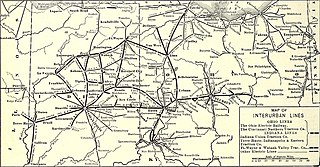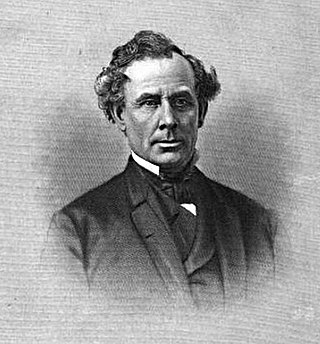The Little Miami Railroad was a railway of southwestern Ohio, running from the eastern side of Cincinnati to Springfield, Ohio. By merging with the Columbus and Xenia Railroad in 1853, it created the first through-rail route from the important manufacturing city of Cincinnati to the state capital, Columbus. In this period, railroads were important for creating connections between the important waterways of the Great Lakes and the Ohio River, which were major transportation routes for products to other markets.

The Cincinnati and Lake Erie Railroad (C&LE) was a short-lived electric interurban railway that operated in 1930–1939 Depression-era Ohio and ran between the major cities of Cincinnati, Dayton, Springfield, Columbus, and Toledo. It had a substantial freight business and interchanged with other interurbans to serve Detroit and Cleveland. Its twenty high-speed "Red Devil" interurban passenger cars operated daily between Cincinnati and Cleveland via Toledo, the longest same equipment run by an interurban in the United States. The C&LE failed because of the weak economy and the loss of essential freight interchange partners. It ceased operating in 1939.
The Cleveland, Cincinnati, Chicago and St. Louis Railway, also known as the Big Four Railroad and commonly abbreviated CCC&StL, was a railroad company in the Midwestern United States. It operated in affiliation with the New York Central system.
The Pittsburgh, Fort Wayne and Chicago Railway was a major part of the Pennsylvania Railroad system, extending the PRR west from Pittsburgh, Pennsylvania, via Fort Wayne, Indiana, to Chicago, Illinois. It included the current Norfolk Southern-owned Fort Wayne Line east of Crestline, Ohio, to Pittsburgh, and the Fort Wayne Secondary, owned by CSX, from Crestline west to Tolleston in Gary, Indiana. CSX leased its entire portion in 2004 to the Chicago, Fort Wayne and Eastern Railroad (CFE). The remaining portion of the line from Tolleston into Chicago is now part of the Norfolk Southern's Chicago District, with a small portion of the original PFW&C trackage abandoned in favor of the parallel lines of former competitors which are now part of the modern NS system.

The Pittsburgh, Cincinnati, Chicago and St. Louis Railroad, commonly called the Pan Handle Route, was a railroad that was part of the Pennsylvania Railroad system. Its common name came from its main line, which began at Pittsburgh, Pennsylvania, crossed the Northern Panhandle of West Virginia, and continued west to Bradford, Ohio, where it split into a northern line to Chicago and a southern one through Indianapolis, Indiana, to East St. Louis, Illinois.
The Cincinnati and Richmond Railroad was part of the Pittsburgh, Cincinnati, Chicago and St. Louis Railway system.
The Jeffersonville, Madison and Indianapolis Railroad (JM&I) was formed in 1866 as a merger between the Indianapolis and Madison Railroad and the Jeffersonville Railroad.

Chauncey Rose was an American businessman during the 19th century.
The Cleveland, Columbus and Cincinnati Railroad (CC&C) was a railroad that ran from Cleveland to Columbus in the U.S. state of Ohio in the United States. Chartered in 1836, it was moribund for the first 10 years of its existence. Its charter was revived and amended in 1845, and construction on the line began in November 1847. Construction was completed and the line opened for regular business in February 1851. The CC&C absorbed a small bankrupt railroad in 1861, and in May 1868 merged with the Bellefontaine Railway to form the Cleveland, Columbus, Cincinnati and Indianapolis Railway.
The Columbus to Chicago Main Line was a rail line owned and operated by the Pennsylvania Railroad in the U.S. states of Ohio, Indiana, and Illinois. The line ran from Columbus, Ohio northwest via Logansport, Indiana to Chicago, Illinois. Junctions included the Columbus to Indianapolis Main Line via Bradford, which split at Bradford to reach the Pittsburgh to St. Louis Main Line at New Paris, Ohio; the Fort Wayne Branch at Ridgeville, Indiana; the Richmond Branch at Anoka, Indiana; and the South Bend Branch and I&F Branch at Logansport.
The Pittsburgh to St. Louis Main Line was a rail line owned and operated by the Pennsylvania Railroad in the U.S. states of Pennsylvania, Ohio, Indiana, and Illinois. The line ran from Pittsburgh, Pennsylvania west via Steubenville, Ohio, Columbus, Ohio, Dayton, Ohio, Indianapolis, Indiana, Terre Haute, Indiana, and Vandalia, Illinois to East St. Louis, Illinois. In addition to its east end in downtown Pittsburgh, where it met the Main Line and Pittsburgh to Chicago Main Line, junctions included the Columbus to Chicago Main Line at Columbus, the C&X Branch at Xenia, the Columbus to Indianapolis Main Line via Bradford at New Paris, the Richmond Branch and Fort Wayne Branch at Richmond, the Louisville Branch and I&F Branch at Indianapolis, and the Peoria Branch at Farrington, Illinois.

The Central Railroad Company of Indiana is a Class III short-line railroad that owns 92 miles (148 km) of track between Cincinnati, Ohio, and Shelbyville, Indiana, with trackage rights on CSX to Indianapolis, Indiana. CIND interchanges with CSX, Indiana & Ohio Railway, and Norfolk Southern in Cincinnati, and in North Bend, Ohio, with CSX; an Indiana & Ohio branchline splits from the CIND line at Valley Junction, a railroad location near Hooven, Ohio.

The Indianapolis and Bellefontaine Railroad (I&B) was an American railroad founded in 1848. It changed its name to the Indianapolis, Pittsburgh and Cleveland Railroad (IP&C) in 1854. Its counterpart in Ohio was named the Bellefontaine and Indiana Railroad (B&I). The B&I ceased to exist as an independent company when it merged into the Bellefontaine Railway in September 1864. The Bellefontaine Railway merged with the Cleveland, Columbus, and Cincinnati Railroad to form the Cleveland, Columbus, Cincinnati and Indianapolis Railway in December 1864.

The Cincinnati, Indianapolis and Western Railroad was established in 1915 as a reorganization of the Cincinnati, Indianapolis and Western Railway, which in turn had been created in 1902 as a merger of the Indiana, Decatur and Western Railway (ID&W) and the Cincinnati, Hamilton and Indianapolis Railroad (CH&I).
The Indianapolis Union Railway Company, is a terminal railroad operating in Indianapolis, Indiana. It was organized on May 31, 1850, as the Union Track Railway Company by the presidents of the Madison and Indianapolis Railroad (M&I), the Terre Haute and Richmond Railroad (TH&R), and the Indianapolis and Bellefontaine Railroad (I&B) for the purposes of establishing and operating joint terminal facilities in Indiana's capital city. The name of the company was changed to its present one on August 12, 1853. The next month, on September 20, Indianapolis Union Station opened its doors, becoming the first union railroad station in the world. Since 1999, the company has been owned and operated by CSX.

The Ohio Electric Railway was an interurban railroad formed in 1907 with the consolidation of 14 smaller interurban railways. It was Ohio's largest interurban, connecting Toledo, Lima, Dayton, Columbus, and Cincinnati. At its peak it operated 617 miles (993 km) of track. Never financially healthy, the company went bankrupt in 1921 and was dissolved into its constituent companies.

The Ohio Southern Railroad operated between Ironton, Ohio, and Lima, Ohio, from 1893 and 1905. Beginning in 1878 as the narrow gauge Springfield, Jackson and Pomeroy Railroad, it ran from Jackson-Wellston, Jackson County to Springfield, Ohio. The line was converted to a standard gauge by 1880 and renamed the Ohio Southern Railroad in 1881. From Jeffersonville, branch lines were started towards Columbus to the northeast and Cincinnati to the southwest, but never completed. By September 1893, the Ohio Southern had reached north to Lima with a bridge over the Great Miami River at Quincy. At Lima, the freight could link to the Lima Northern Railway for points further north. In 1898, the Lima Northern became the Detroit and Lima Northern Railroad (D&LN). Ohio Southern depots continue to stand in St. Johns, Uniopolis, Jackson Center, Quincy, and Rosewood.

Stillman Witt was an American railroad and steel industry executive best known for building the Cleveland, Columbus and Cincinnati Railroad, Cleveland, Painesville and Ashtabula Railroad, and the Bellefontaine and Indiana Railroad. Through his banking activities, he played a significant role in the early years of the Standard Oil company. He was also one of the founding investors in the Cleveland Rolling Mill, a major steel firm in the United States.










